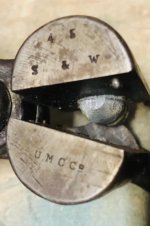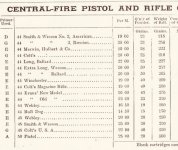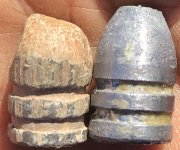I've been unbelievably lucky lately finding 45 Schofield relics. I just won this mold at auction. Can't wait to dissect it.
I know from period catalogs that UMC (Union Metallic Cartridge Co) manufactured and sold reloading kits for the 45 Schofield but I have never seen one. I have only seen a few parts photo'd. Never have I seen a bullet mold of this early design in 45 S&W. Very exciting piece of history!
It's an amazing find and notice from the auction photos that the bullet appears to mimic the Arsenal double lube grove inside lubricated bullet. However, it is a heeled bullet, not hollow based like the Arsenal round. I can't wait to measure the cavity.
I'll post more detailed photos when it arrives.
Murph
I know from period catalogs that UMC (Union Metallic Cartridge Co) manufactured and sold reloading kits for the 45 Schofield but I have never seen one. I have only seen a few parts photo'd. Never have I seen a bullet mold of this early design in 45 S&W. Very exciting piece of history!
It's an amazing find and notice from the auction photos that the bullet appears to mimic the Arsenal double lube grove inside lubricated bullet. However, it is a heeled bullet, not hollow based like the Arsenal round. I can't wait to measure the cavity.
I'll post more detailed photos when it arrives.
Murph











